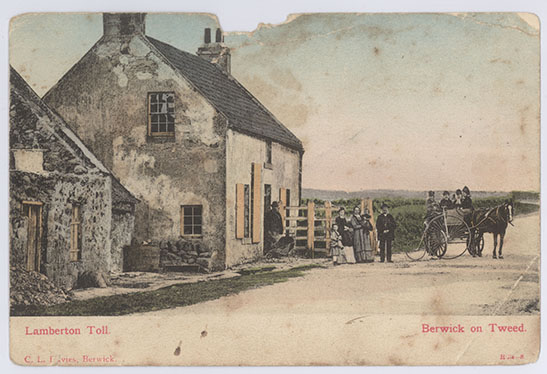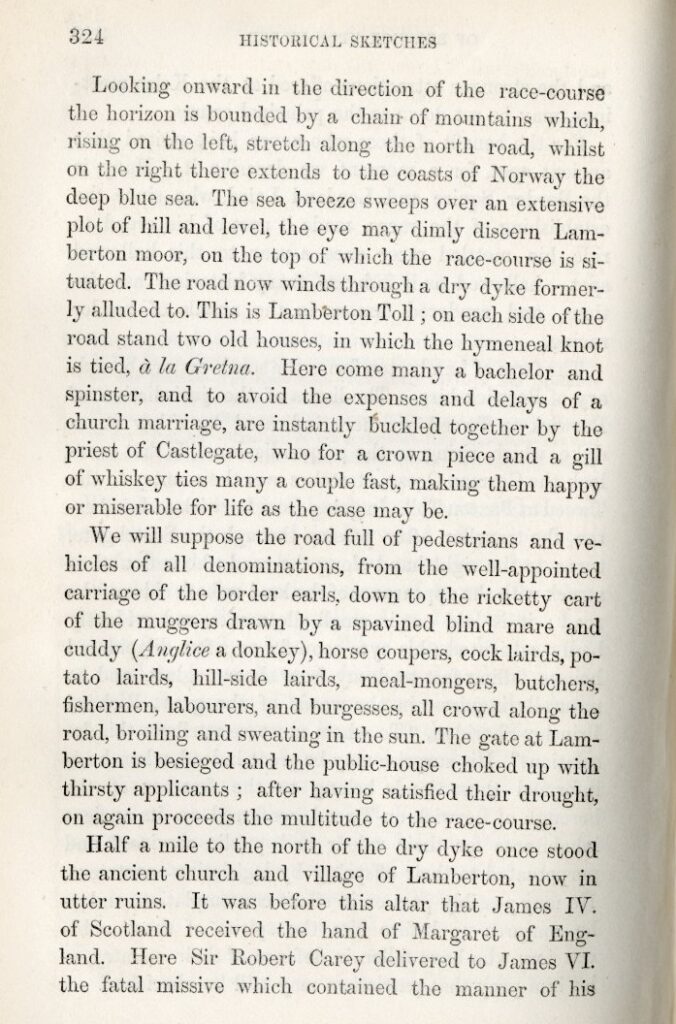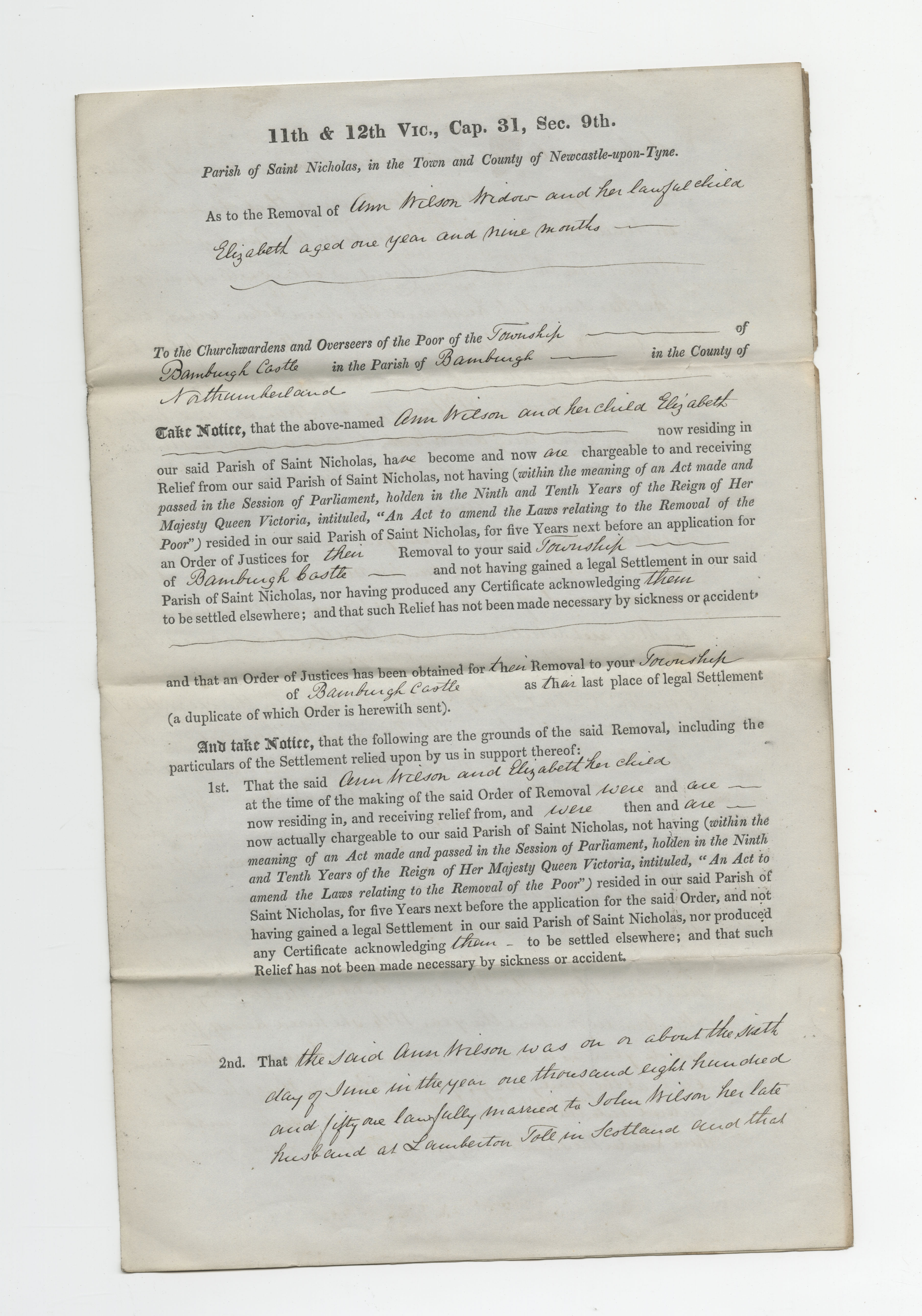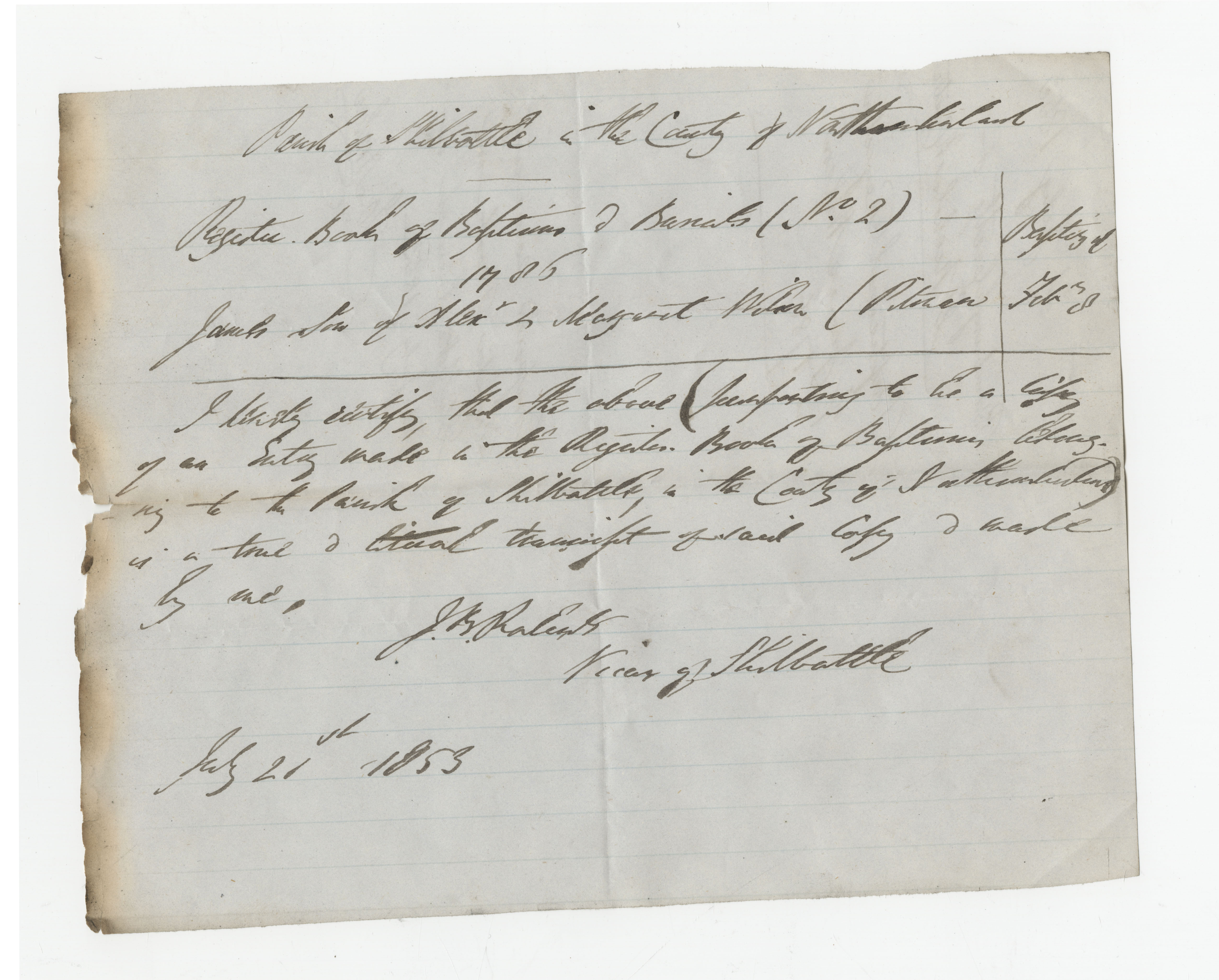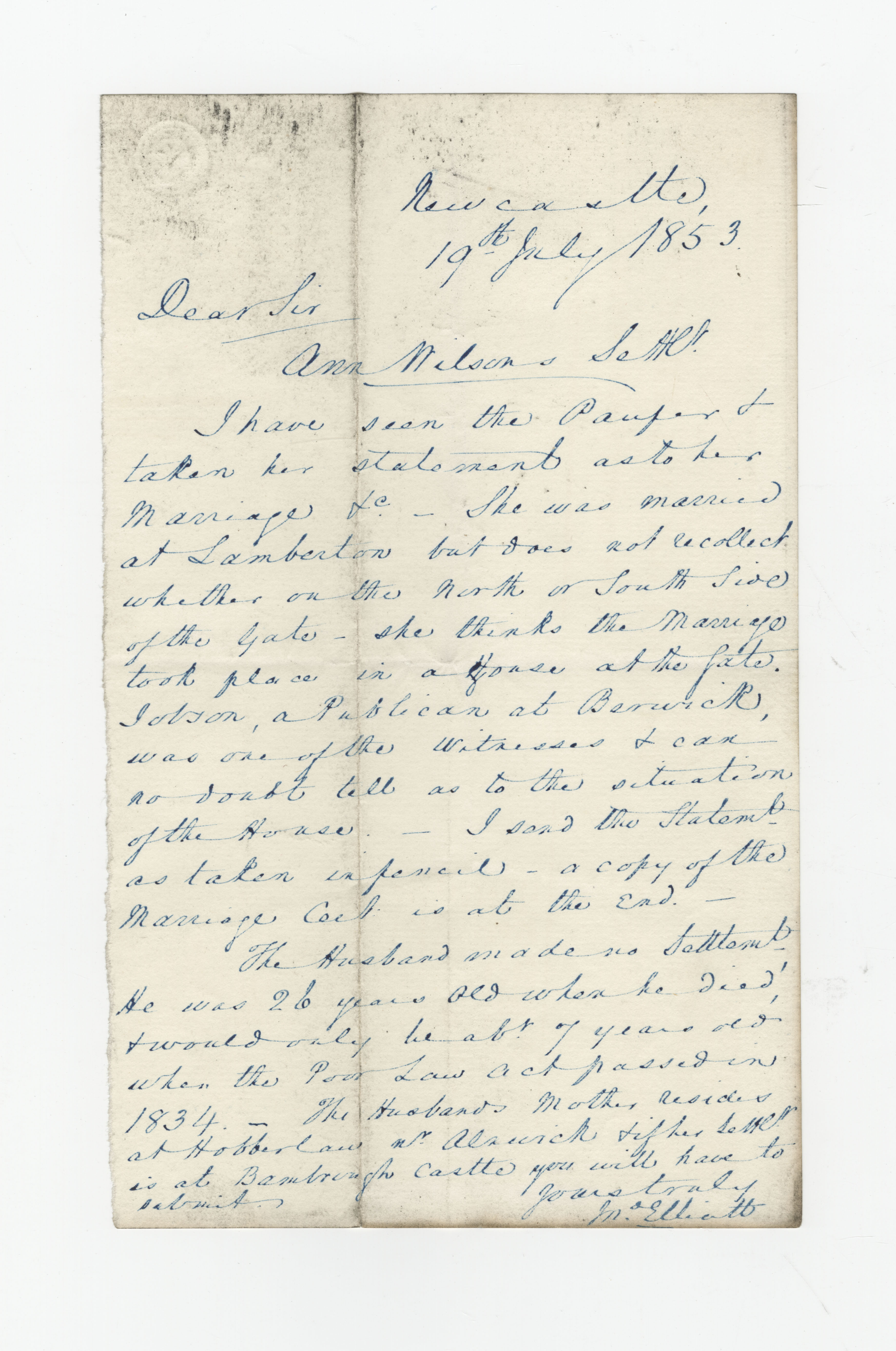BORDER MARRIAGE HOUSE
THREATENED WITH DEMOLITION
The celebrated Border Marriage House at Lamberton, on the Great North Road, between Ayton and Berwick, was under discussion at the east District Committee meeting at Ayton on Thursday last. This historic relic passed some time ago into the hands of the Scottish Board of Agriculture when they acquired Lamberton for the purpose of a small holding settlement. It was then in rather poor repair and more recently, at the instance as is understood of the occupants, it was condemned by the Medical Officer of Health for Berwickshire as unfit for human habitation. Correspondence between the East District Committee and the Board of Agriculture followed, and the subject of what was to be done engaged the attention of the Committee on more than one occasion. The position taken up by the Board practically amounted to this: they had no use for the house in connection with their scheme and could not or would not see their way to expend anything upon its repair for letting purposes. In the long run they virtually asked the Committee to issue a closing order and put an end to the matter. On Thursday this came before the Committee in the usual course.
Mr Coupland, Sanitary Inspector for the County, on being asked his opinion, said he considered it would be rather a pity to issue a closing order in this case and that it would have been preferable if means could be employed to compel the proprietors to put it into order. The Chairman asked if they were obliged to issue this closing order, to which Mr Coupland replied that it was unfortunate that the Committee had not taken action under Section 25 of the Housing and Town Planning Act (Scotland) 1919 and issued an order to the proprietors to have it put into order. If they failed to do so, the Committee could then proceed to execute the necessary repairs and charge the proprietors with the cost. This statement appeared to cast a new light upon the matter and Mr Usher remarked that he did not see that the Board of Agriculture should be allowed to neglect its duties any more than a private individual. It was also pointed out that a closing order, if carried out, involved demolition, and also threw upon the Committee the onus of providing alternative accommodation. The question arose as to whether the Committee could rescind its former minute on the subject, out of which the present proceedings arose. The Joint Clerk (Mr T. P. Doughty) gave it as his opinion that the Committee could not there and then do so, but he was under the impression that this could be done at next meeting, by there being put on the agenda in a regular way a notice to rescind the minute in question. The Board had said they were not prepared to carry out the repairs required to make the house habitable, and on June 23rd, 1923, the Committee practically resolved that a closing order would be granted. The Chairman (Mr K. G. Turnbull) said the Clerks might look into the matter and see if it was practicable to proceed under Sec.25, and thee matter could be taken up fresh at next meeting.
Dr McWhan said he had formerly represented the house as uninhabitable, and he was of the same opinion still. He did not think it was necessary to take any action until certain circumstances changed.
Mr Campbell Renton – if any accident happens, whose is the liability?
This set the discussion o another task. Mr Anderson stated that the gable had sagged away 1 ½ feet from the roof, and Mr Doughty in allusion to the legal aspect of the matter said he did not think it was ever contemplated when the Act was passed that an owner could come to an Authority and ask for a closing order. Dr McWhan said there was for too much tinkering with old property. The place would have to be practically rebuilt. Mr Coupland said that as matters stood they would have to find the occupants a house.
The Chairman – But we can’t find them a house.
Mr Campbell-Renton – I understand they are simply “squatters.” They are paying no rent.
Mr Hogarth protested against taking down an old landmark if it could be helped and was supported by one or two members. Eventually Mr bell moved that a closing order be issued and was seconded by Mr Russell. Mr Hogarth moved that the Committee do not issue a closing order, and was seconded by Mr Patterson, Chirnside, who said that in view of the admitted scarcity of houses in the district the Committee should not do anything to lessen their number unless they had no other course.
Mr Anderson – Closing the house does not mean demolition?
Mr Coupland – Yes it does.
Mr Usher moved that the matter be continued until next meeting and that in the meantime the Clerks should look into the question of the practicability of another line of procedure. This was seconded by Mr Cockburn and the other motions being withdrawn, became the finding of the meeting.
MARRIAGES AT LAMBERTON
Lamberton got its name – like many other places in the Southern shires of Scotland – from an early Saxon settler, Lambert, whose “tun” it became (says “Weekly Scotsman”). He must have squatted here early, before the reign of David I, as in the charter which that king gave to Berwick one of the witnesses is William de Lambertourn.
“On each side of the road,” says Sheldon in his Historical Sketches (1849), “stand two old houses in which the Hymeneal knot id tied a la Gretna. Here comes many a bachelor and spinster, and to avoid the expense and delay of a church marriage are instantly buckled together by the priest of the Castle gate, who for a crown piece and a gill of whisky ties many couples fast…… Half a mile to the north of the dry dyke once stood the ancient church and village of Lamberton.”
Lamberton Toll weddings are very interesting, as the show, perhaps better than any, how popular and extended were Border marriages at a certain period. From distant towns and scattered villages from isolated hamlets and farms, a wonderfully large number of young couples made Lamberton the Mecca of their desires, a Mecca only to be reached after a long and weary journey over roads none too well kept in those days.
One marriage certificate I have shows the parties lived in the borough of Tynemouth; another, South Shields; and one came from the little cluster of houses – Rochester-on Watling Street. This latter pair had to walk miles to the south before going east through Rothbury to reach Longframlington, where they turned left-handed to get on the Great North Road – even then they were 60 miles from the Borders. These are only a few of the several cases which could be brought forward to prove that distance was no object to the old-time lovers.
Some would no doubt get a kindly lift, others would go by the stagecoach, or other cheaper stage waggon. The majority went there is little doubt, on “Shanks, his pony.” The principal reason for this pilgrimage seems to have been that a deeply-rooted objection to marriage in a church prevailed in the northern part of England by night.
An amusing story is told of a pair who arrived at the house with the priest before a fire had been lighted in the “parlour.” A match was hastily put to the “coal fire,” but the chimney being cold and damp, refused to draw, and belched out volumes of smoke into the room, until it was like to choke them all. The bridegroom being touched in the wind, bore it worst of all. He became so distressed with the smoke and the slowness of the priest that he shouted. “Hoots, man: that’ll de. How much de ye want?” and, after throwing down the fee, he seized his bride and rushed for the open air -half-married.
Like most of the other places where Border marriages were celebrated, Lamberton provided cases for the Courts of Law. Some were of bigamy, largely through ignorance. How an obliging disposition, when it runs counter to the laws, may end in disaster, was demonstrated in a case which came before Mr Justice Cresswell at Durham, when Jospeh Atkinson pleaded guilty to having married William Brown and Catherine Cossar at Berwick-on-Tweed. The couple had made their way to Lamberton, but on arrival found that Atkinson had gone to Berwick. They followed and ran him to ground in the Old Hen and Chickens in bridge Street. At first, he refused to tie the know unless they returned with him to Lamberton, but they declared that their relations were possibly following, and further pressed argument and drink on him until, when the night was far spent, he complied. On returning home he entered the transaction as having been performed at Lamberton. At his trial all his pleadings were of no avail, and he was sentenced to transportation for seven years.
According to an informant, most of the priests were either tailors or shoemakers living in Berwick. An old weaver told me of a wedding at which after a supper and a taste of the tollman’s whisky – which seems to have figured largely both before and after the ceremony-the newly-wedded couple were rolling merrily away in their carriage when the candles in the lamps set fire to the woodwork. “it was a bonny hullabaloo,” in his words, “on fire and no water anywhere near.”
The Lamberton Toll marriage certificates possess are in several forms. Some, neatly printed, have been taken from a book with counterfoils. Others have been given an important legal look by the heading “This is to certify,” or “Whereas this witness,” in highly decorative penmanship. Others again are on any odd piece of paper which might be at hand. Still, they served their purpose as well as if they had been signed by a bishop or an archdeacon and were quite as much thought of years ago as any very special license is today.
They were perfectly good legal evidence, and were accepted as such in the law Courts, and as evidence of presumptive age, I know of at least one case where a Lamberton Toll marriage certificate secured the old pension for a man who could not produce a certificate of his birth and who did not know where he had been born.
As a regiment of soldiers was stationed at Berwick, to say nothing of the militia, Lamberton came in for a handsome share of their marriage fees. So did the Berwick Magistrates. These extracts from the Register of Marriages at Berwick in the 17th century show the mayor or a Magistrates officiated.
“Thomas Houghes, Captain under the command of Colonel George Fenwick, in the Garrison at Leath, in Scotland, and Grace, daughter of Mr John Saltonstall, late Alderman of Berwick, before Stephen Jackson, Miar for this year.”
The entries generally are “quaint” as regards spelling, and it is very noticeable that a very large number of officers and men took away wives as souvenirs of their stay in the Border town which is neither English or Scottish.
In the last week of the last year when toll marriages were valid the local press contained a paragraph indicative of the rush to be in at the finish.
“There were, we are informed, no fewer than 13 marriages celebrated on Sunday week, and 8 on last Sunday, while we have no doubt that a large number are still pending to be completed before the departure of the present year.”
The priests actually did a roaring trade up to the last legal day, and numerous announcements appeared in the first numbers of the local “weeklies” of the next year.


